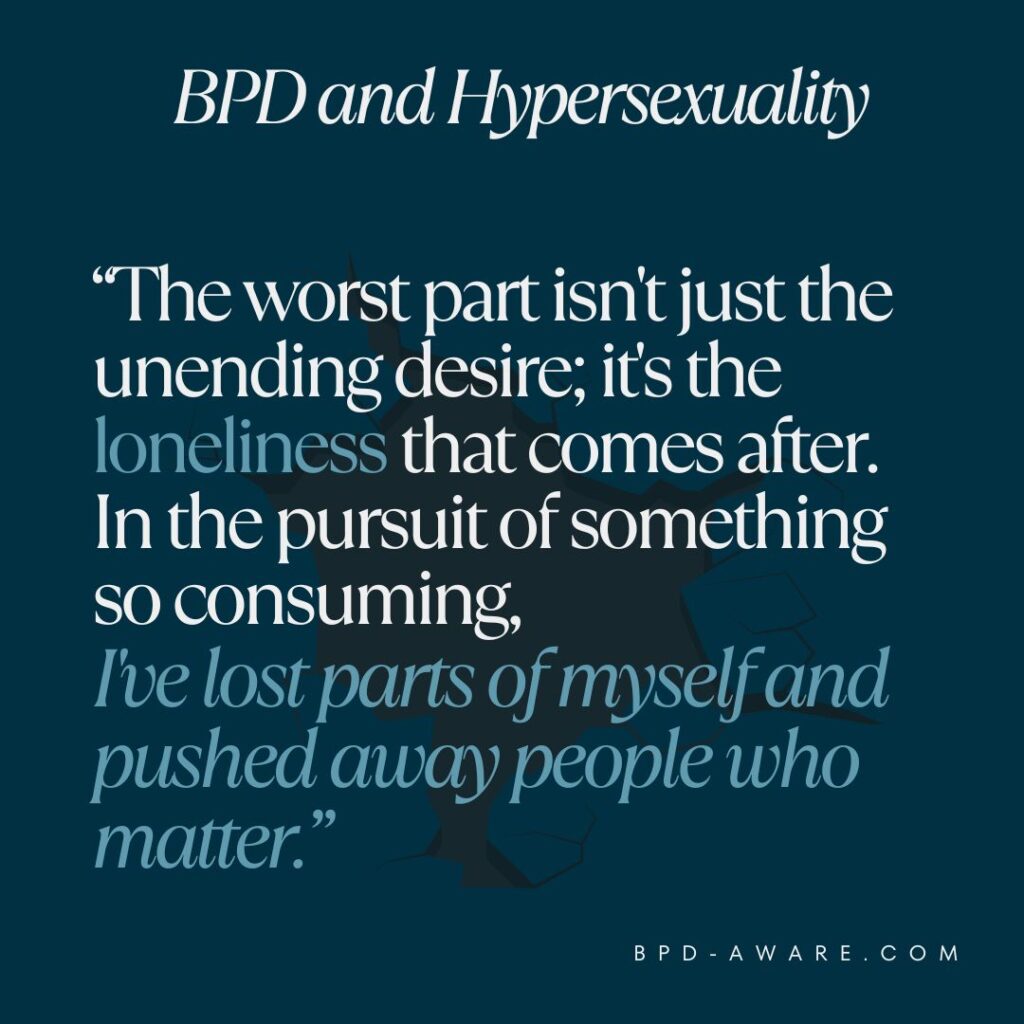Hypersexuality is a disorder defined by an excessive preoccupation with sexual fantasies, urges, or behaviors that are distressing or disruptive to one’s life. It can lead to significant personal, professional, and social difficulties. While not officially classified as a distinct disorder in the Diagnostic and Statistical Manual of Mental Disorders, Fifth Edition (DSM-5), hypersexuality can be a symptom of other mental health conditions or the result of various biological, psychological, or social factors.
The relationship between hypersexuality and Borderline Personality Disorder (BPD) can be complex. Hypersexuality may manifest in people with BPD as part of their impulsive behavior patterns. This impulsivity is a core feature of BPD and can include a variety of behaviors aimed at avoiding real or imagined abandonment, seeking identity, or managing intense emotional states. Sexual impulsivity or hypersexuality in BPD patients may serve as a coping mechanism or form of self-defense to deal with emotional pain, to feel validated, or to avoid abandonment. It’s also suggested that the heightened sensitivity to rejection and the intense emotions characteristic of BPD can lead to seeking out intense, often sexual, experiences as a form of validation or emotional regulation.
However, it’s important to note that not everyone with Borderline Personality Disorder experiences hypersexuality, and not all individuals who experience hypersexuality have BPD. The manifestation of hypersexuality in BPD can be diverse, reflecting the diversity of the disorder itself.
What it Feels Like to Be Hypersexual
Being hypersexual involves experiencing an unusually high level of sexual thoughts, urges, or behaviors that can feel overwhelming and difficult to control. The experiences and feelings associated with hypersexuality can vary widely among individuals, but common aspects include:
- Intense Sexual Urges: Individuals may feel powerful sexual desires that are persistent and intrusive. These urges can be so strong that they interfere with daily life, making it hard to concentrate on tasks, maintain relationships, or fulfill responsibilities.
- Compulsive Sexual Behavior: A person may engage in sexual activities more frequently than they desire or in ways that conflict with their values or intentions. This can include excessive use of pornography, masturbation, engaging in risky sexual behaviors, or using sex to cope with negative emotions.
- Difficulty with Emotional Regulation: Hypersexuality can be a way to escape or manage uncomfortable emotions such as stress, anxiety, depression, or loneliness. Individuals might use sex as a temporary relief from their emotional pain or to fill an emotional void.
- Impact on Relationships: The intense focus on sexual activity can strain or disrupt personal relationships. Partners may feel neglected, misunderstood, or unable to satisfy the hypersexual person’s sexual needs. It can also lead to secrecy or dishonesty, further complicating relationships.
- Guilt and Shame: Despite the compulsive nature of their behavior, individuals with hypersexuality often experience significant guilt, shame, or self-loathing over their actions. These feelings can stem from societal norms, personal values, or the negative consequences of their behavior.
- Sense of Loss of Control: Many describe feeling powerless over their sexual thoughts and behaviors. This loss of control can be distressing and lead to a sense of hopelessness or despair about their ability to change their situation.
- Difficulty Seeking Help: Recognizing the problem and seeking help can be challenging. Individuals may fear judgment or not realize that their sexual behavior is a symptom of a larger issue that can be addressed with professional help.

BPD and Hypersexuality
Individuals with BPD may be more prone to hypersexuality due to a combination of emotional, psychological, and behavioral factors inherent in the disorder. The relationship between BPD and hypersexuality can be understood through several key aspects of BPD:
- Impulsivity and Risk-Taking Behavior: Impulsivity is a core characteristic of BPD, and it manifests in various ways, including substance abuse, binge eating, and risky sexual behaviors. Individuals with BPD may engage in hypersexual activities without considering the consequences, seeking immediate gratification or relief from emotional distress.
- Emotional Dysregulation: People with BPD experience intense emotional swings and could struggle to manage their emotions as a result. Hypersexuality can serve as a coping mechanism to temporarily alleviate or escape from painful emotional states such as loneliness, depression, anxiety, or feelings of emptiness.
- Fear of Abandonment: People with BPD often have an intense fear of abandonment, which can lead to efforts to avoid abandonment, both real and imagined. Sexual relationships or encounters may be pursued aggressively as a means to feel wanted, connected, or to secure emotional closeness, albeit in a potentially unhealthy or unsustainable way.
- Identity Disturbance: BPD is associated with a persistent identity disturbance, including an unstable self-image or sense of self. Engaging in sexual activities may be a way for some individuals with BPD to explore or affirm their identity, seek validation from others, or feel powerful and desirable.
- History of Trauma: A significant number of individuals with BPD have a history of traumatic experiences, including physical, sexual, or emotional abuse. Hypersexuality can sometimes be a manifestation of unresolved trauma, where sexual behavior becomes a complex way of re-enacting trauma, seeking control over past experiences, or coping with trauma-related emotions.
- Difficulty with Relationships: Given the intense and unstable interpersonal relationships characteristic of BPD, individuals may turn to sexual relationships as a way to experience connection or intimacy. However, this can further complicate their personal relationships and emotional well-being.
It’s important to recognize the presence of hypersexuality can also be influenced by other factors beyond BPD such as co-occurring mental health disorders, substance use, and individual life experiences.
The Dangers of Hypersexuality
Hypersexuality can lead to a range of problems in someone’s life, impacting various aspects including personal relationships, emotional well-being, professional life, and physical health. Here’s how it can cause issues:
- Relationship Problems: Hypersexual behavior often puts a strain on romantic relationships. The person’s excessive focus on sex can lead to neglect of their partner’s emotional and physical needs, causing feelings of inadequacy, jealousy, or betrayal. Infidelity can erode trust and quickly ruin relationships.
- Emotional Distress: Individuals with hypersexuality may experience intense guilt, shame, and self-loathing, especially if their behaviors conflict with their personal values or societal norms. This can exacerbate feelings of isolation and depression, potentially leading to a cycle of increased sexual activity as a flawed coping mechanism.
- Professional and Academic Consequences: The preoccupation with sexual thoughts or engaging in sexual activities can interfere with work or academic performance. This might result in missed deadlines, decreased productivity, disciplinary action, or even job loss. Students may struggle with concentration and academic performance, impacting their future opportunities.
- Financial Problems: Hypersexual behavior can sometimes involve spending excessive amounts of money on pornography, sex workers, dating apps, or related activities. This can lead to financial problems, further exacerbating stress and emotional distress.
- Legal Issues: Engaging in risky or unlawful sexual behaviors, such as public indecency, solicitation, or accessing illegal pornography, can result in legal consequences, including fines, incarceration, or being placed on a sex offender registry.
- Health Risks: Hypersexuality increases the risk of sexually transmitted infections (STIs) and unwanted pregnancies due to engaging risky sexual practices or having multiple sexual partners. It may also lead to physical injury or exhaustion from excessive sexual activity.
- Social Isolation: The guilt and shame associated with hypersexuality can lead people to withdraw from friends, family, and social activities. This isolation can be damaging to the individual’s mental health, creating a vicious cycle that fuels further hypersexual behavior.
- Impact on Self-Identity and Self-Esteem: Struggling with hypersexuality can lead to confusion and conflict about one’s identity and worth, particularly if the person feels unable to control their behaviors or align them with their values.
Because hypersexuality can have such profound and diverse impacts on someone’s life, treatment is highly recommended. This may include psychotherapy to address underlying emotional or psychological issues, medication to treat any co-occurring mental health conditions, and support groups to provide a sense of community and shared experience. The goal of treatment is not only to manage hypersexual behavior but also to address the broader emotional and psychological needs of the person, aiding them in developing healthier coping mechanisms so they can begin to rebuild their life.

Treatment For Hypersexuality
Treating hypersexuality involves a multi-faceted approach, addressing both the behavior itself and any underlying psychological, emotional, or medical causes. Treatment options vary depending on the person’s circumstances, including the presence of any co-occurring disorders such as Borderline Personality Disorder, Bipolar Disorder, or substance abuse issues. Here are the primary treatment options available for hypersexuality.
Psychotherapy
- Cognitive Behavioral Therapy (CBT): CBT helps people to recognize and change negative thought patterns and behaviors. It’s effective for managing impulsive behaviors, including hypersexuality, by teaching coping strategies and ways to deal with triggers. Evidence supports its use in reducing symptoms of hypersexuality and improving self-control.
- Dialectical Behavior Therapy (DBT): Originally developed for BPD, DBT focuses on teaching skills to improve interpersonal relationships, manage emotional distress, and develop mindfulness. It’s useful for individuals whose hypersexuality is linked to emotional dysregulation or BPD.
- Psychodynamic Therapy: This therapy addresses the underlying emotional conflicts and past experiences (such as trauma) that may contribute to hypersexual behavior. It’s more exploratory and long-term than CBT and DBT.
- Group Therapy: Group therapy can offer a supportive environment to share experiences and strategies. Being amongst people with similar problems can reduce the feelings of shame and isolation associated with hypersexuality.
Medication
- Selective Serotonin Reuptake Inhibitors (SSRIs): SSRIs, a type of antidepressant, can be effective in treating hypersexuality by reducing sexual desire and compulsive behaviors. They are often used when hypersexuality is part of an obsessive-compulsive spectrum.
- Mood Stabilizers and Antipsychotics: In cases where hypersexuality is associated with Bipolar Disorder, Borderline Personality Disorder, or other mood disorders, mood stabilizers or antipsychotic medications may be prescribed to address the condition, which can help reduce hypersexual behavior.
- Naltrexone: An opioid antagonist, naltrexone has been used off-label to treat compulsive sexual behaviors by reducing the pleasure associated with the behavior, thereby decreasing the urge to engage in it.
Lifestyle and Self-Care
- Mindfulness and Stress Management: Techniques such as meditation, yoga, and regular exercise can help people manage stress and lessen the desire to engage in hypersexual behaviors. For more on this, see our article about living a healthy life and how it helps reduce symptoms of BPD.
- Healthy Relationships and Social Support: Building and maintaining healthy, non-sexual relationships can provide emotional support and reduce feelings of isolation or loneliness.
The choice of treatment depends on the individual’s unique requirements and the underlying factors contributing to hypersexuality. Treatment needs to be personalized and potentially include multiple approaches for the best outcomes. Regular follow-up and adjustment of the treatment plan may be required to address the needs of the individual if they change.
Final Thoughts
Hypersexuality can emerge as a maladaptive coping mechanism for individuals facing emotional, psychological, or relational turmoil. This condition becomes maladaptive when it is used persistently as a way to escape, manage, or numb complex emotions or stressors, rather than addressing the underlying issues directly. In this context, hypersexuality is not merely about high sexual desire but represents an attempt to cope with or mitigate difficult feelings and experiences.
The use of hypersexuality as a coping mechanism can stem from various psychological or emotional difficulties, including trauma, anxiety, depression, low self-esteem, and particularly, personality disorders such as Borderline Personality Disorder. For some, engaging in sexual activities or dwelling on sexual thoughts serves as a temporary relief or distraction from pain, loneliness, or a sense of emptiness. It can also be a means to seek validation, connection, or control, especially in individuals who have experienced neglect, abuse, or instability in their early relationships. However, this coping strategy is maladaptive because it often leads to a cycle of short-term relief followed by long-term problems, such as relationship issues, emotional dysregulation, guilt, and further psychological distress.
Addressing hypersexuality requires a comprehensive treatment approach that goes beyond managing the sexual behaviors themselves to understanding and healing the underlying emotional wounds. Therapy, particularly modalities like Cognitive-Behavioral Therapy and Dialectical Behavior Therapy, can be effective in teaching healthier coping strategies, improving emotional regulation, and fostering a deeper understanding of one’s behaviors and their impacts. In addition to psychotherapy, medication may be used to treat co-occurring conditions such as depression or anxiety, thereby reducing the need to rely on maladaptive coping mechanisms. Moreover, cultivating a supportive network, engaging in self-care practices, and developing new, healthier ways to cope with stress and emotional pain are crucial steps toward recovery.
Ultimately, recognizing hypersexuality as a maladaptive coping mechanism is a pivotal step in the journey toward healing. By addressing both the symptoms and the root causes, individuals can learn to navigate their emotions and relationships more effectively, leading to a more balanced, fulfilling life. The path to overcoming hypersexuality is not linear and requires patience, understanding, and the support of trained professionals, but it is a path that leads to genuine recovery.
Sources, Resources, and Further Reading
- Sexual Behavior in Borderline Personality: https://pmc.ncbi.nlm.nih.gov/articles/PMC3071095/
- BPD & Sexuality: Understanding the Connection: https://www.choosingtherapy.com/bpd-and-sexuality/
- The Effect BPD Has on Your Sex Life: https://respark.co/blog/the-effect-bpd-has-on-your-sex-life/
- The Curse of BPD: Hypersexuality, Secrets and Shame: https://beatanxiety.me/the-curse-of-bpd-hypersexuality-secrets-and-shame/?srsltid=AfmBOoqR5SZ-MScON5kX_GTvWoT6FWszNx0YUIbxzHfHD_Hvw_k71Gcm
















